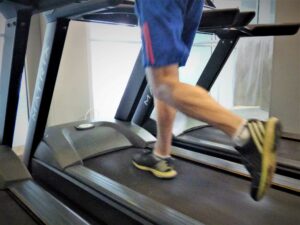Shin splints is a term used commonly for pain in the shin. It’s as simple as that. There are of course many different causes of shin pain though, the most common of which is termed ‘medial tibial stress syndrome’ (MTSS).
MTSS is an irritation in the periosteum (the lining of the bone) and has been suggested to be very similar to the reaction in the build-up to a stress fracture. The diagnosis however, does not include that of stress fracture, but is considered a bony stress reaction. It can also encompass tendinopathy of the adjoining tendons or a dysfunction of the tibialis posterior, tibialis anterior or soleus muscles.
Wolff’s Law (1892) suggests that the bone of a healthy person or animal will adapt to the loads under which it is placed. Click here to see an amazing picture of this concept in action where a fibula changed into the shape of a tibia! However, the forces exerted on a bone by a muscle can also cause an adaptation. When the amount of force exerted on the bone is too high for it to adapt quickly enough or is exerted consistently without enough time to rest, a negative reactive occurs. This is MTSS or if it’s too much, a stress fracture.
Effectively, it’s not the tissue that’s the problem, it’s the stress placed on it.
If you have pain in your shin, it is a really good idea to discuss this with a sports injury specialist since it is very important to rule out certain stress fractures and to ensure that you really do have shin splints and there isn’t another cause of your pain such as compartment syndrome or vascular problems – these can require very different treatment and can be very dangerous to try to run through.
MTSS has been reported to affect up to 35% of runners at some point, and can prevent you from running or doing impact exercise for anything from 4 weeks to 18 months – which in my experience always seems to happen at the most critical part of training!
This is a really difficult question to answer as it is very difficult. Generally speaking, MTSS affects the inside of the middle and bottom 1/3 of the shin which spans at least 5cm (although some stress fractures can be diffuse like this too). There are however some other characteristics that MTSS presents with:
· No swelling
If any of these statements are untrue, that is when I would suggest asking a professional.
When you think back to your training, something significant has often changed too – it may be you are new to running, you have increased mileage very quickly, you have been running downhill more, changed your trainers or even started running on the concrete rather than grass.

It is very much an overload injury, and this is really important to consider when trying to decrease the risk of MTSS. There are other risk factors too, some of which can be changed, and others can’t.
Increased pronation – there seems to be a link with the amount your foot turns in when running. Too much pronation is not always the issue though and we need to be careful with this – anecdotally I have seen a lot of people who develop shin pain after starting to ware a shoe that restricts pronation. A theory may be that by stopping pronation we loos the ability to absorb load.
Increased BMI – the heavier you are, the more force goes through your tibia.
Increased plantar flexion – actually having increased mobility in your ankle can impair its shock absorbing abilities.
Narrow step width – this can increase the rate of pronation, causing increased force on the tibia.
Lower cadence – a cadence under 170steps/min increases ground reaction forces.
Increased hip external rotation – increased external rotation at the hip also seems to be related to MTSS.
It’s really interesting to see that the idea that tightness is a cause of MTSS does not seem to be supported in the literature. Instead it’s more about improving control of movement.

No – not if it hurts to do so.
Sorry, that’s abrupt, but it needs to be said. If, when you run your pain flares up, and it’s more than a little niggle (I’d suggest under 4/10 pain) or if it is still painful for you to walk day to day, you should not be running.
Also, don’t expect that after having 2 weeks off running, you will then be able to go straight back to where you started from, it doesn’t work like that. You need to gradually build up, and this takes time, remember we are asking bone to adapt.

Stop running. Again, there are not many times I tell someone to stop running, but this is one. Stop until the pain is gone when walking, and then start a progressive running program.
Other than this, if you are looking for a quick, short term pain relief try these:
· K-tape – Sometimes placing some kinesiotape under the arch and up the inside of the shin can help with pain.

This is the best question – we don’t like quick, short term fixes, and shin splints is not a quick fix – ask anyone that has had it.
As said already, it is essential that you offload the area by decreasing your impact exercise enough to calm it down first – don’t keep doing what you’ve been doing, the reason you have read all the way through this article is because what you were doing isn’t working!!!!
Next, you need to do exercises. Different people need to focus on different exercises depending on where their risk factors are, but here are some generic exercises we have put together for you – click here.
Progress these exercises and your running plan gradually. If it’s not working for you though, it may be necessary to see someone who specialises in sports injuries. You may need more specific advice or treatment.
